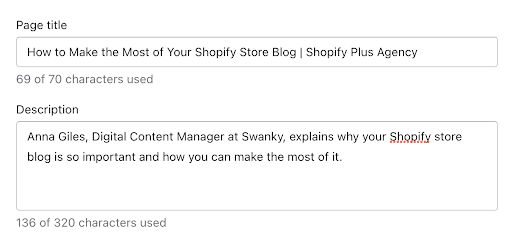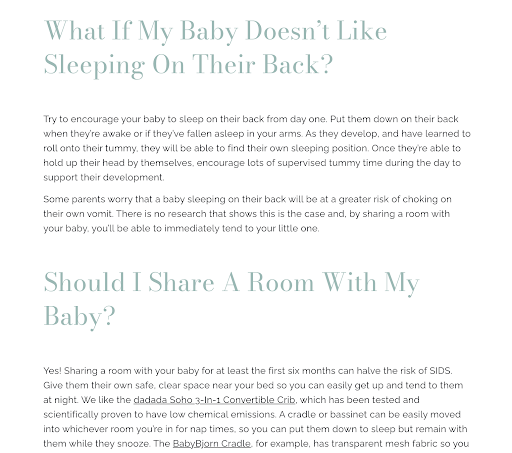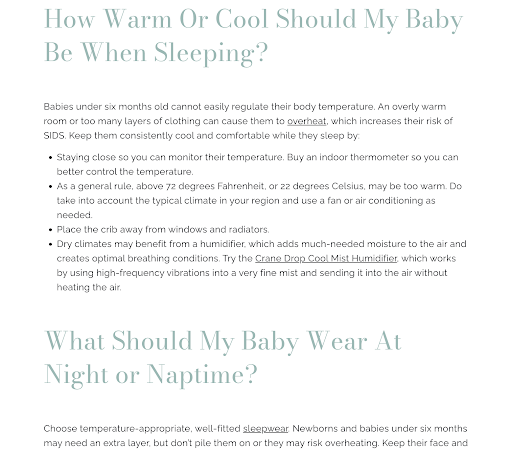How to Make the Most of Your Shopify Store Blog
Swanky’s Senior SEO & Content Manager, Anna Giles, has spent years planning and implementing results-driven content marketing strategies for clients across the globe. Join her as she discusses why your Shopify store blog is so important and how you can make the most of it.
Written By
Anna Giles

Traffic acquisition is the North Star for all ecommerce business owners. You can’t convert without traffic. And whilst there’s nothing wrong with assigning big budgets to Facebook, Instagram and Google Ads, merchants and marketers need to add another string to their bow – mastering the art of blogging.
Making the most of your Shopify store blog is a hugely underrated traffic acquisition strategy. One that is often overlooked and under-prioritised. Blogging has a much longer shelf life, requires less financial investment and can ultimately bring in a higher ROI than paid advertising.
The pay-off isn’t as instantaneous as paid advertising, we know that. However, putting the leg work in now with blogging and other types of organic content will lay a good foundation – think high SERPs rankings and a steady increase in traffic to your site. It’s worth the wait. We talk more about the benefits of content marketing here.
The value of your Shopify store blog
Helps consumers find answers to their questions
The value of a consistent stream of well-crafted blog copy cannot be underestimated. Over time, it will become an invaluable resource for driving new shoppers to your site and building relationships with pre-existing customers.
Successful content creation lies at the intersection of brand expertise and popular search queries. Good content should aim to draw from your brand’s expert knowledge and skill, whilst matching the search intent of the reader. Blogging is an opportunity to provide helpful, engaging answers to the reader’s questions, problems and pain points. It shouldn’t be primarily used to push or “hard sell” your own products.
Ask yourself this question: how are you going to help potential consumers find what they’re searching for?
Introduces new readers to your brand
Most readers arriving on your Shopify store blog for the first time are simply looking for an answer to their question. They may only just be discovering your brand. These readers at the top of the ecommerce sales funnel are most likely looking for inspiration or help. They’re not really looking to make a purchase.
You can introduce readers to your brand through engaging content that answers their questions. By including calls-to-action (CTAs) in your blog content, you can effectively help a new reader take their next step in discovering your brand. Why not offer the opportunity to sign up for a free sample, trial or starter pack? Even a link to “find out more” could be the next step in their journey to making a purchase.
Builds loyalty with existing consumers
Another way to make the most of your Shopify blog is by creating content that builds relationships with your existing customers. Posting technique tips and tricks, interviews, recipes, information on charitable partnerships and aftercare advice, for instance, all goes towards building engagement with and confidence in your brand.
Tell your story and set yourself apart from the competition by offering information on how to get the most out of your products. Sometimes your product may be incredibly niche and there’s only so much you can write about. Creating lifestyle content can help attract readers who may be interested in your product – topics that are more loosely related to your product offering.
The point of blog content in this scenario is not about providing a hard sell. You’re demonstrating an understanding of your target reader – writing about what they are interested in. It will go a long way to enhance the value of your brand.
What can you do with a Shopify blog?
A Shopify blog provides a simple, user-friendly interface that will support the content strategy for your brand. It’s easily customisable, with the capacity to store and display a great deal of content.
You can:
- create and manage posts;
- add and edit content and media;
- add tags (to help readers find a topic of interest and to organise your content);
- add post excerpts for displaying on your blog feed;
- manage blog comments from readers;
- manage SEO fields for each post, including page titles and descriptions;
- set the URL for each post; and
- schedule publishing date and time.
Your blog doesn’t have to exude stylistic or creative prowess to win readership and convert. The simplicity of consistent, well-organised content is the key. Choose a blog page template from within your Shopify theme that best suits your brand, and weave your brand colours and typography into the design for consistency.
SEO tips for making the most of your Shopify store blog
1) Keyword research
In-depth keyword research (using tools like Semrush, Moz and Google Analytics) is an essential part of understanding what your audience is searching for. And crucial for making the most of your blog. What exactly are they asking? And with what frequency? Keyword targeting should be tactical. Aim to target keywords that both give your audience help with a specific problem, and those that will drive revenue to your store.
2) Page titles
First off, ensure that you’re using the SEO fields on the Shopify blog page (see the screenshot below) – this is the data that will be used when the page is loaded and shown to the reader.
Make sure your page title is sitting between 50 and 65 characters long, and is both user-friendly and keyword-optimised. SEO best practice suggests fronting the page title with your target keyword(s) and, where appropriate, ending with your brand name separated by the pipe or dash symbol.
3) Meta descriptions
A meta description is the text snippet that appears below the title tag on a results page. It should succinctly summarise what is on the page as it informs the reader of what to expect and serves to generate click-throughs from SERPs.

These are two of the SEO fields on your Shopify store blog – one for page title and one for meta description.
Sometimes Google will pull through the text you insert in the SEO field, but other times, it will pull through other relevant information, such as that found in other headings (H2s and H3s, for example). It’s always worth optimising your meta description to increase click-throughs. After all, the more people that click on your result, the more likely Google will increase your ranking in search results.
Meta descriptions should aim to be between 120 and 155 characters – a little more space to play with. Google seems to typically truncate descriptions at around 155-160 characters, so try not to exceed this otherwise it won’t display.
Check out the Yoast blog to find out more about best practices for meta descriptions.
4) Link building
Creating internal links to other pages within your site will see both an uplift in readers’ time on site and an increase in page views. Link building (especially to product and category pages) makes it easier for Google to crawl your articles and see the connectivity between your pages.
A rule of thumb is to create a link to three or four other pages every 1000 words. That’s three or four links per blog post – if you average between 800-1500 words per article.
External or outbound links to trusted, authoritative sources can also help create a strong profile within the link graph algorithm which, in turn, helps with ranking. The Search Engine Journal helpfully comments, “Search engines create maps of the Internet called Link Graphs and these maps help search engines determine whether or not a site is relevant or low quality and how the site fits into the Internet. Link graphs are a part of ranking and for that reason it’s important to understand what they are…”.
5) CTAs
Calls-to-action (CTAs) in a blog post guide your reader to make a next step. They are a critical part of generating leads on your website. From slide-in or sidebar CTAs, to blog subscription CTAs at the bottom of the post, there are many ways to include them in your blog.
You can also encourage connection on social media by inviting people to follow your company on the platform most relevant to them. Sometimes you may want to include something that unlocks a discount or provide an incentive to make a first purchase or trial. Including CTAs in your Shopify blog will pave the way for turning readers into customers.
Check out our guide to creating effective CTAs, packed with tips on how to achieve the perfect design and craft click-worthy copy.
6) Optimised headings
Catchy, keyword-optimised headings are vital for SERP rankings, and they also help guide the reader through the article. Let’s face it, most of us skim-read long articles to get to the information we really want to read.
Strike a balance between catchy, attention-grabbing headlines and keyword-optimised, concise headings. Ideally, the content on your Shopify store blog should be developed enough to include H2, H3, H4 and sometimes H5 headings.


These keyword-optimised headings guide users through the blog article, helping them quickly identify sections that are most relevant to them.
7) Word count, sentences and paragraphs
A good word count target for a blog post on your Shopify site is 1500-1700. And for a good readability score, keep your sentences short and make sure your paragraphs aren’t too bulky. Long chunks of text are off-putting and difficult to read. According to Yoast SEO – a plug-in SEO app now available for Shopify blogs – sentences shouldn’t clock up more than 20 words.
If you’re consistently writing sentences of more than 20 words, you run the risk of a low readability score, which will have a negative impact on your SEO. Shorter sentences are easier to read, more engaging, and you’ll be able to communicate your message more effectively.
8) Visuals
Humans predominantly learn visually, and with a Shopify blog, it’s easy to add images and embed videos. Just make sure you don’t forget to add image alt tags. Not only will this improve your SEO score, it will ensure your site is accessible to those with visual impairments.
9) Categorisation and tagging
Structuring your content is a great way to improve user experience on your blog. Shopify allows you to create tags that help organise your blog posts into categories, or by subject.
For example, you could create a category called ‘pet care’ by tagging all your blog posts that talk about looking after a pet. Readers can then click on that tag to find other blog posts on that same theme.
And, what’s more, when a customer searches for a tag in your online store, they’ll be able to view relevant blog posts in the search results. Just make sure your tags consist of as few words as possible – one or two words, to prevent the tag URLs from being too long.
Key takeaway: don’t neglect your Shopify store blog
As an ecommerce marketer, a data-driven blogging strategy should be a top priority. As well as working wonders for your organic search exposure, it builds brand authority and strengthens relationships with customers.
Leverage the tips I’ve shared in this article to make the most of your Shopify blog and craft informative, authoritative, engaging content that both your customers and search engines will value.
Ecommerce content marketing specialists
Our dedicated in-house content team is made up of experienced copywriters, technical SEO experts and visual designers. Together, they’ll reignite your ecommerce content marketing strategy, creating engaging, optimised articles for your Shopify store blog.
Contact our friendly team of Shopify Plus Experts to find out how we can unlock your ecommerce potential.

